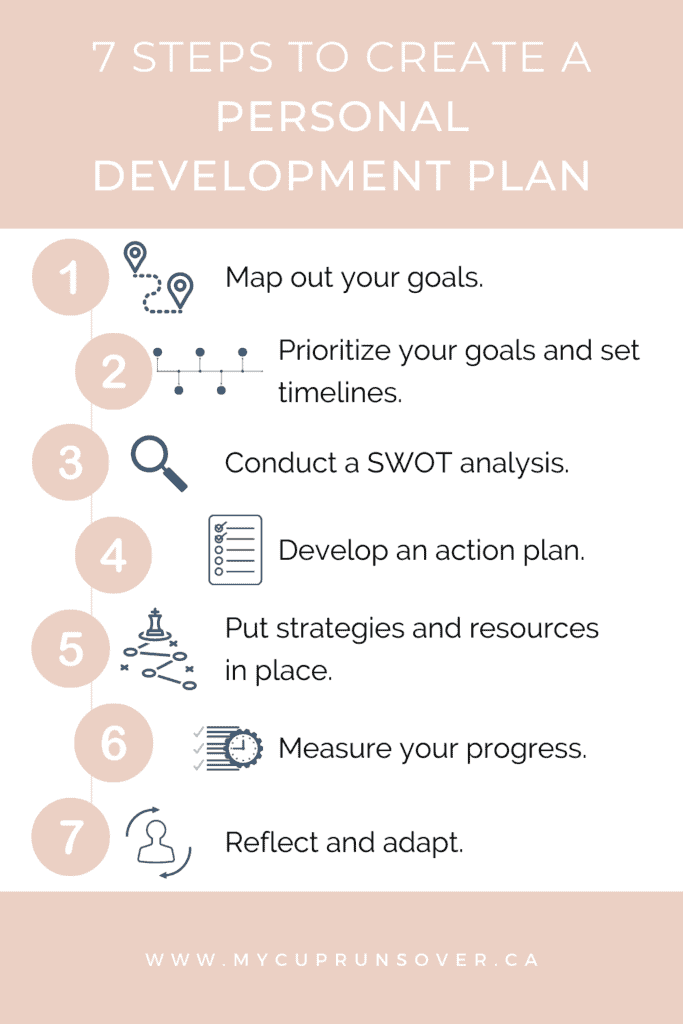Do you feel paralyzed when you think about your dreams for the future? Like there’s so much you want to do and achieve and you have no idea where to start? If you’re feeling stuck when it comes to making progress toward your long-term goals, a personal development plan could be exactly what you need to chart your path and take the first step on the road to success.

Affiliate disclosure: This post may contain affiliate links, which means we may receive a commission if you click a link and purchase something that we have recommended. Please read our disclaimer for more details.
Charting Your Personal Development Journey
It’s easy to get stuck in routines in both your personal and professional life. You spend so much time just trying to get everything that’s currently on your plate done that you have little time left over for career development or pursuing new skills. You get stuck on a hamster wheel, running like mad but never getting anywhere.
If you have the sense that there must be more to life than you’re currently experiencing, you’re not alone. The global personal development market was valued at $41.84 billion USD in 2021 because both employees and employers realize the importance of continuous learning as we all try to keep up with a rapidly changing world.
Whether you work for an employer, are self-employed, or are a stay-at-home mom with an unconventional career path, making a personal development plan will help you articulate your personal goals, set priorities, take the necessary actions, and hold yourself accountable. Whatever type of work you do, operating with a growth mindset—the belief that you can develop your skills and abilities over time—will help you achieve any big goal you set for yourself.
What is Personal Development?
Personal development encompasses any activities you undertake to help you improve your skills, knowledge, and experience. Examples include reading books, attending conferences and workshops, taking courses and seminars, pursuing certifications, volunteering, and working with a mentor.
Personal development doesn’t only apply to your professional growth, but also to your personal life. You may have goals around physical health, hobbies, relationships, or travel that factor into your overall plan and need to be considered alongside your career goals. After all, you are not just a worker bee. You are a complete human being who has only twenty-four hours in the day. Your personal and professional goals need to be in harmony with each other.
A big part of personal development planning is changing your habits and rhythms to better serve your end goal. You may need to develop a morning or evening routine that includes certain activities—such as reading or reflecting—that help you move in the right direction. This could involve rearranging your schedule or giving up other activities that are not serving you as well.

Personal development often does require that you make some sacrifices to create room for your development efforts. You may have to give up some time with friends or spend less time on social media so you can put in the work necessary to achieve your dreams and aspirations. It’s not always fun, but if you’ve set your goals well, it’s worth it.
What is a Personal Development Plan?
A personal development plan is a strategic roadmap that will help you get from where you are now to where you want to go. Once complete, it will act as a guideline for your life, laying out each next step you need to take to accomplish all of the amazing things you want to do.
Benefits of a Personal Development Plan
Having a strategic plan to guide you in achieving your life goals is an important step in the goal-setting process. This useful tool will help you:
- Articulate your goals. People who articulate and write down their goals are much more likely to accomplish them than those who don’t. A personal development plan helps you take your goal setting to the next level. You will think through your goals in a clear and deliberate way and come up with a detailed action plan for achieving them.
- Stay focused on your goals. Despite our best intentions, the busyness of life can distract us from making the progress we’d like to make toward our goals. We start out great but get easily thrown off track when something happens to interrupt our schedule. Having a personal development plan keeps your goals front and center and gives you something to realign yourself with when you get off track.
- Get motivated. Personal development is hard work and hard work doesn’t usually feel too appealing. Once we get into the nitty-gritty activities we would rather not be doing, it’s tempting to throw in the towel. Having a clear understanding of the big picture can help you maintain motivation through the less exciting stages.
- Maintain a sense of purpose. Knowing that you are working toward something large and meaningful instills your life with such a great sense of purpose. It drives you to get up in the morning and do what it takes to get the job done.
- Make better decisions. Without a rudder, it’s impossible to steer a ship. Without a plan, it’s equally difficult to steer the ship of your life. Your personal development plan gives you a destination and a route and makes it possible for you to make the decisions you need to make to stay the course.
- Reduce stress. Having a plan for your life is one of the best stress reduction methods available. Your plan helps you feel like you’re in control, even while accepting that full control is not within anyone’s grasp (Hello, 2020!). But knowing the general direction you intend to travel, and having planned milestones along the way where you check in and re-plot the route if necessary, assures you that your life has greater meaning and that you’re taking the right steps to fulfill your potential, which greatly reduces anxiety.
- Improve your time management skills. For those of us who are on the more ambitious side, writing down our goals and our planned course of action in a personal development plan makes it clear whether our timelines are realistic or not. If we write our plan and realize it would take us twenty-seven hours a day to accomplish it, we know we need to go back to the drawing board. Once we have narrowed our steps down to a manageable level, sticking with the plan still requires that you set aside a certain amount of time each day or week to work on your goals. You’ll quickly see that if you don’t use this time well, you won’t make the progress you want to see.
Examples of Personal Development Goals
Before we discuss the most effective way to write your personal development plan, you may be wondering what kind of goals you should include. In general, you may want to add:
- Long-term and short-term goals (common timelines include 1, 3, 5, and 10 years or some combination thereof)
- Personal and professional goals
- Health goals (physical, mental, emotional)
- Relationship goals
- Family goals
- Travel goals
- Financial goals
- Education goals
Here are several examples from one person’s 1-year section of their personal development plan:
Career
- I have a literary agent
- I have a growing social media platform
- I’m working on my next book
- I’ve joined a critique group
- I am earning $5000/month from sales and partnerships
Education
- I’ve taken an SEO course
- I have a certification in copyediting
- I’ve attended a writing conference
Family
- We spend time together as a family most nights of the week
- We have taken a family vacation
- My spouse and I have a weekly date night
Health
- I walk 8,000 steps per day
- I do yoga three times a week
- I sleep 8 hours most nights
Finances
- I’ve paid off my credit card
- I’ve added $10000 to my RRSP
If you nee some inspiration, we’ve put together some goal-setting resources to help you come up with your own goals.
How to Write a Personal Development Plan
Now it’s time to start putting together your own personal development plan. There are seven steps in this process.
- Map out your goals
- Prioritize your goals and set timelines
- Conduct a SWOT analysis
- Develop an action plan
- Put strategies and resources in place
- Measure your progress
- Reflect and adapt

1. Determine Your Personal and Professional Goals
The first step in your personal growth journey is to set your goals. In our personal development plan template, we’ve included a spreadsheet page (titled 1-GOAL SETTING) that you can use to help think through your goals and document them.
It’s a good idea to spend several hours or even a few days thinking through your goals. After you make the first draft, take a couple of days away from it, then come back, read it over, and see how you feel. Does it excite you? Does it feel ambitious and a little scary? If you achieved everything on the list, how satisfied would you feel?
If the goals you’ve written don’t invoke this kind of enthusiasm, push yourself to think bigger. Your dreams should be bigger than what you think you can currently achieve. That’s the thrilling part. We’re going to take something you couldn’t have believed you would accomplish, and we’re going to get you there! If this is going to be a roadmap for your life, you need to feel genuinely excited about it.
As you brainstorm your goals, don’t be afraid to be honest with yourself. You’re not likely to share this document with anyone else unless you’re working with a professional coach or you’ve been asked to create your PDP as a requirement of your current job. Don’t refrain from owning your dreams out of fear of what others would say if they saw them.
This is your life and your plan. You and you alone get to determine what goes in it. For each goal that you set, make a note of the why. Why is this particular goal important to you? How does it fit in with the rest of the plan? Why is it worth working hard for? Stating your why in advance will make it so much easier to stick with your plan when you start to feel discouraged.
Here are two quick exercises that might help you envision this future life.
- Describe your ideal day. In your journal, give a detailed accounting of what a perfect day would look like for you in five or ten years. What would you do? Where would you be? Who would be there? Then, think about the things you’d need to accomplish to make this perfect day your reality.
- Write your obituary. Though it seems morbid, this exercise, which I first learned about from Donald Miller’s Hero on a Mission course, is extremely effective in helping you figure out what matters in your life. Start by writing a one to two-page summary of your life as though you have already reached the end of it. Talk about the things you accomplished and what you will be remembered for. Again, use this to find clarity around the goals you need to set if you want that life to be your reality.
2. Prioritize Your Goals and Set Timelines
At this stage of the process, you want to start giving some shape to this list of goals you’ve come up with. Over time, you’ll tackle everything on your list, but you can’t do everything at once.
That’s where prioritization comes in.

Think about the order in which you need to accomplish things. For example, if one of your goals is to earn a degree or certification and another is to make a career change, figure out which one of those needs to happen first. Do you need that higher education before you can get a better job, or does your current job make it impossible for you to pursue formal training outside of work? Questions like this will help you figure out the best order in which to tackle things.
Then you’ll put timelines to your goals. Which ones can be accomplished in the short term and which require more time? Be realistic in your estimation of how long things will take, and add extra time as a buffer when you’re making your timeline.
Wherever possible, take on your hardest goals first. Checking off tasks you once deemed impossible will build your self-confidence and give you the momentum you need to keep going.
Use the goal-setting spreadsheet to sort your goals into timelines. When you’re done, you should have a 1-year, 5-year, and 10-year plan. Then, within your 1-year plan, prioritize your top goals for each category. (Use the worksheet titled 2-PRIORITIZATION to help with this).
3. Conduct a SWOT Analysis
Once you’ve figured out where you’re headed, you can now work backward and plot your course. The best way to start is to do a thorough assessment of where you are now and analyze the gap between the skills, experiences, and opportunities you have today and those you’ll need to accomplish your goals.
One way to do this is through a SWOT Analysis. This process will help you evaluate your personal Strengths, Weaknesses, Opportunities, and Threats.
Take a piece of paper and draw two lines—one down the center and one across the middle—to divide it into four squares. Across the top, label the squares Strengths and Weaknesses. Across the bottom, label them Opportunities and Threats. You can also use the SWOT Analysis sheet (titled 3-SWOT ANALYSIS) in the free template worksheet below.
With your list of goals at your side, you’ll fill in these boxes with every relevant strength, weakness, opportunity, and threat you can think of. It might be helpful to go through the questions below one time for each of your goals so you don’t miss anything. (Add to the lists with each pass-through, don’t create a separate list each time).
In the Strengths section, list your current strengths. If you’re not sure what to write, try answering these questions:
- What qualifications or certifications do you have?
- What relevant experience do you have?
- Have you read books or taken courses relevant to your goals?
- What skills do you already possess?
- What do you most enjoy doing?
- What do other people tell you you’re good at?
- What abilities make you unique?
- What interpersonal skills have helped you in the past?
- What makes you who you are?
In the Weaknesses section, list any areas where you are not strong or where you know you lack the skills or experience needed to reach your goals. Answer some or all of these questions:
- What other qualifications, education, or certification is necessary to reach your goals?
- Where do you lack experience?
- What skills are still new to or emerging for you?
- What tasks do you most dislike doing?
- Where do you struggle the most?
- Which internal factors create the biggest obstacles for you? (e.g. motivation, procrastination, self-doubt.)
- What bad habits will you need to break?
- Where do you most need to improve?
- In what areas do you look to others in your field and feel less competent?
In the Opportunities section, think about the external trends or opportunities that could help you reach your goals. Reflect on these questions:
- Is there a growing demand for the type of work you want to do?
- Do you have a strong personal or professional network you can lean on?
- Is there anywhere you could volunteer your skills/services while you’re honing them?
- Is there a conference or event scheduled that you could take advantage of?
- Does your company offer funding or support for continuing education or personal development?
- Is there someone you can collaborate with for support, encouragement, and accountability?
Finally, in the Threats section, list any external opposing forces that could get in the way of you pursuing your long term goals Think about the following questions:
- What obstacles in my personal life will I have to overcome to make time and space for personal development? (e.g. finding childcare, having more help at home, getting access to the necessary equipment.)
- What kind of competition will you face?
- How will the current economy impact your progress?
- Will financing your goals be a challenge?
- Do you have any personal health issues that need to be considered?
- Do you lack access to training and education opportunities?
- Do you feel like your personal support network is too small or nonexistent?
- Do you face a lack of support from your spouse or other family members?
4. Develop an Action Plan
The next step is to make a detailed action plan for how you’re going to tackle your goals. If you have your goals segmented into timelines (1, 5, and 10 years, say), your action plan should cover the first period (i.e. one year).
For each of your short-term (1-year) goals, list the actions you’ll need to take to get to your goal. These will become your milestones, helping you track your progress in key areas. What needs to happen each quarter, month, week, and day over the next year for you to be successful?
Let’s use one of the career goals from the examples section above and demonstrate how this works.
Goal: I have a literary agent
Using the Personal Development Plan template, match up your strengths, weaknesses, opportunities, and threats with each specific goal.
For example:
I have a literary agent:
Strengths: I’ve written a solid novel, beta readers have responded positively to it, I’d had it professionally edited, I’ve attended several workshops on how to find an agent
Opportunities: There’s a writer’s conference next month and I could connect with literary agents there, Publisher’s Marketplace had a thorough listing of agents and the authors they represent, a friend of mine has a great agent she’s willing to introduce me to
Weaknesses: I’m a first-time novelist, I don’t have great credentials, I don’t have much of a platform
Threats: My novel is not in one of the trending genres, publishers are being very selective about whose work they acquire, there are many other aspiring novelists right now with better qualifications and connections
Next, list the actions you need to take this quarter to move you toward your goal or improve your current skills.
This quarter, I will submit my work to fifteen agents, attend a writer’s conference, and write a short story to submit to a magazine or anthology.
Then break those goals down into things you can accomplish in the next month.
This month, I will research agents and make a list of fifteen to query. I will register for a writer’s conference and I will take a copy of Writer’s Market out of the library and research publications that are open to submissions.
Your detailed plan should include the strategy you’ll use to get this done.
I will spend the first Saturday of the month at the library so I can complete all of these tasks.
Finally, plan to reward yourself for accomplishing your monthly goal.
When I hit my goal for this month, I’ll go to my favorite bookstore and treat myself to a new novel and a latte.
To make this process easier, I’ve created a Personal Development Plan template you can use to answer all these questions. Download it below.
5. Put Strategies and Resources in Place
Setting your goals and creating an action plan is a huge accomplishment and you’ve done well to make it this far. The next—and most important—step is to make sure you actually follow through with your plan. Taking your desired actions is the key to getting from where you are now to where you want to be.
Here are a few strategies to help you stay on track.
- Review your goals daily. Some personal development experts recommend reading your goal sheet daily. Other suggest rewriting it daily or writing your list of goals in your journal from memory. Whichever method you choose, a regular review of your goals is essential. You want to keep them fresh in your mind and remind yourself what it is you’re working toward. This will keep you motivated when the short-term challenges seem insurmountable.
- Have a daily top three. When you review your goals each morning, write down the top three tasks you need to accomplish that day. No matter how big or small they are, tackling three to-dos every day ensures you make steady progress toward your goals.
- Dedicate specific times of day to personal development. One of the best ways to establish a productive rhythm of personal development habits is to wake up an hour earlier in the morning and dedicate that hour to yourself. Wake up before the rest of your family so you can have uninterrupted quiet time. If you plan out your top three tasks before you go to bed the night before, you can wake up and tackle them as soon as you’re awake. This time will soon become your most productive time of day. (Just make sure you adjust your bedtime routine so you’re not losing any sleep—that would be counterproductive for your personal development journey. You need to take care of both body and mind).
- Build a support network. Goals are easier to pursue when we have friends cheering us on. Find an accountability partner either in your existing friend group or online. There are tons of Facebook groups you can join to find like-minded individuals who are striving to better themselves and don’t want to go the journey alone. Look around and find one that speaks to you, then put out a call for an accountability partner or two. Make a plan to check in with each other a few times a month to share your wins and challenges. If you’re looking for more support, consider working with a professional coach.
6. Measure Your Progress
You’ll also want to check in with yourself on a regular basis and record your progress. Set a weekly time (Friday afternoon or Saturday morning could work well) to review your progress for the week and realign yourself if you’ve gotten off track.
Your weekly check-in should take into account what you’ve accomplished, what you didn’t, what’s working for you, and what’s getting in your way. Make a plan for what you’ll tackle in the week to come and any new strategies you might need to adapt.
For example, if you find your morning time is getting interrupted by phone notifications and you’re not being as productive as you like, resolve to leave your phone off or in another room until after you’ve finished your power hour.
If your plan needs any updates, go ahead and add them in.
Use the fifth worksheet in our template (titled 5-TRACK PROGRESS) to record your actions. You’ll be amazed at how quickly they add up and how inspired you’ll be when you start to maintain a visual representation of how far you’ve come.
7. Reflect and Adapt
Finally, once a year, set aside a day or a weekend to review your plan from top to bottom and give it an annual refresh. Celebrate the accomplishments you’ve made in the past year and develop a new set of goals for the upcoming year based on your 5 and 10-year plans. (These will need updating too). You may want to make a fresh copy of your PDP template and keep the old one intact for record keeping and future contemplation.

Reflect on how the year has gone.
- Did you come as far as you wanted to?
- Which goals did you achieve and which are still in progress?
- Do the same things matter to you as much now as they did then?
- What unexpected events have influenced your course?
- Which habits are serving you and which are getting in your way? How can you amp up the good ones and adapt the negative ones?
- Do you feel more fulfilled than you did a year ago? If not, are the goals you’re working toward the right goals for you?
Write about the answers to these questions in your journal and use them to guide your steps as plan the next phase of your journey.
Grab Your Personal Development Plan Template
Get started on your personal development plan today using our template. It will help you establish your goals and priorities, create an action plan, and track your progress.

Sophie Agbonkhese is a writer, homeschooling mother of four, and a recovering overachiever (who occasionally relapses). She is the founder of My Cup Runs Over, a site dedicated to helping busy women simplify and enrich their lives. When she’s not writing or debugging websites, Sophie spends her time reading, dancing, bullet journaling, reading, gardening, listening to audiobooks, and striving fruitlessly to have a clean house for at least five minutes.



ANIL K. P. MATHAI
Saturday 16th of July 2022
Really thanks dear Madam, appreciate the good messages. thank you for your time and high-level thinking. Keep continuing writing.....
SOPHIE AGBONKHESE
Thursday 13th of October 2022
You're very welcome.